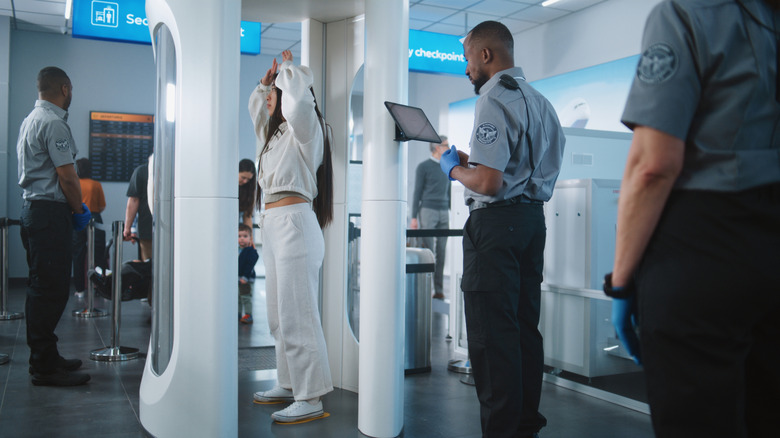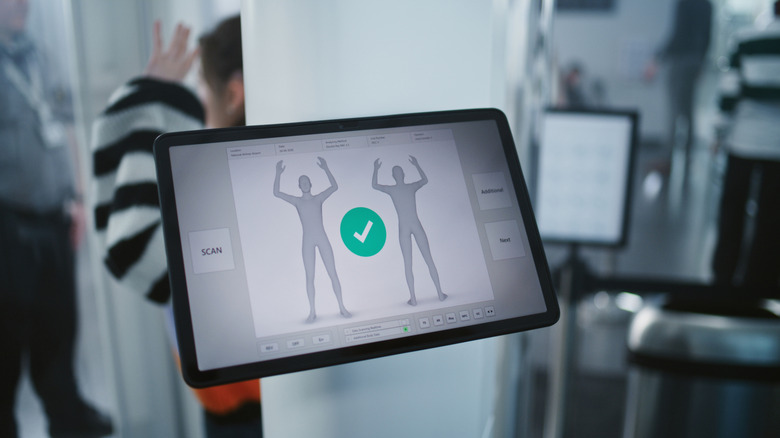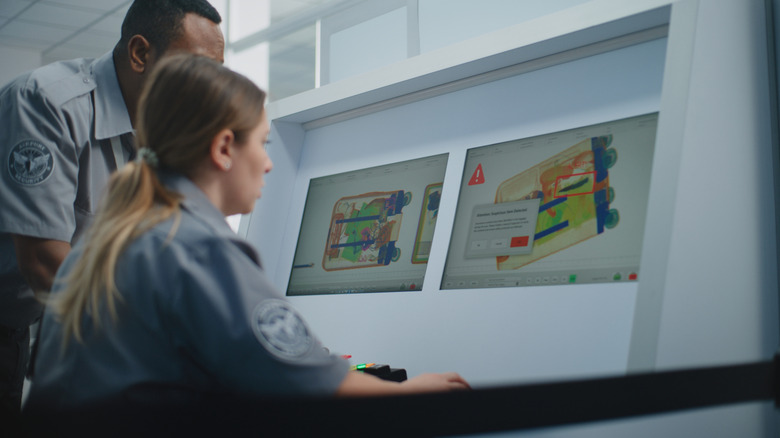What TSA Body Scanners Really See Probably Isn't What You Think
We've all seen those old photos of how chill flights used to be, right? Folks in veritable recliners dining on roast duck using actual silverware on silver platters, laughing while puffing through packs of cigarettes, and doing the truly unimaginable by passing through security with liquid in containers larger than 100 milliliters. But all that fun stuff changed with the terrorist attack on New York City's World Trade Center in 2001.
From 9/11 on, airports adopted a string of tighter and tighter restrictions, bit by bit across the entire globe. We're talking about the smaller liquid containers in a larger, see-through plastic container, the nail clipper-and-file ban, the extraction of your laptop from your bag and placement in a separate bin on the little conveyor belt. Then there's the period where we all had to take off our shoes, the scrutiny from endless security personnel that makes you feel like a convict, and of course, the body scanners — aka the invasive, privacy-ruining, nudity-seeing machines.
At least, that was the fear back when the body scanners showed up. Somehow, the sentiment went, those machines existed to digitally strip a person of their clothes and reveal the skin and hair beneath, which of course would totally help TSA workers identify contraband in a non-distracted way. Some people still think this is the case, or at least worry about it. But have no fear: Body scanners don't reveal love handles or cellulite. They actually work like X-ray machines. Specifically, they emit non-ionizing radiofrequency waves, which bounce off metallic objects, non-metallic objects, and organic materials, any of which will get flagged as suspicious.
Scanners use low-power electromagnetic waves that locate suspicious items
When hearing that TSA scanners — and scanners across the world, actually — use X-ray-like machines to identify no-no items, a person might think, "Well hang on, aren't X-rays dangerous? Isn't that why you've got to get X-rayed in a special room and even sometimes put on a lead vest?" That's true. But as Live Science reports, airport scanners are way, way weaker than medical machines and generate only 0.1 microservients (a measure of radiation) per scan. A regular X-ray emits 100 microservients — that's 1,000 times more radiation.
Plus, airport scanners use advanced imaging technology (AIT) that give off wavelengths slightly above 10 millimeters, which penetrate human tissue less than 1 millimeter deep. Meanwhile, X-ray machines produce much finer wavelengths of 0.01 to 10 nanometers that can peer into your lungs. This is why people with pacemakers, for instance, don't have to worry that an airport body scanner is going to damage the thing in their chest that keeps them alive. With that said, the device might still set a machine off because of its metal components.
But that's okay, because that's what scanners are designed to do. They're just strong enough to detect all those things you've got to empty from your pockets when passing through security, like keys, wallets, coins, watches, etc, as well as substances like drugs and explosive materials. The scanner's electromagnetic waves conveniently pass through clothing but bounce off your skin and any other non-clothing objects. So sorry: Airport scanners aren't snapping close-ups of your business.
What scanners show TSA employees
So if TSA employees aren't drooling over your nudes and they're not Superman who somehow uses X-ray vision to see the visible light spectrum, what do they actually see on their little screens? Security personnel see an outline of a human body — a generic shape that looks like a child's drawing. If the scanning machine catches anything suspicious, a little yellow square shows up at the location of the item. At that point, you're going to get the hand-scanner check or the pat down. And provided you haven't tried to smuggle snakes in your pants or meth in your crutches (real 2024 TSA finds), you should be good to go. And while different models of machines might have different displays, none of them reveal your poorly groomed underhair.
That being said, airports are totally aware that lots of members of the public don't understand this or don't understand how imagining technology works, in general. Concerns over privacy started almost immediately when body scanners got rolled out in the early 2010s, as well as worries over the safety of airport imaging machines. Plus, body scans slow things down, which is the worst thing when you're trying to catch your flight. That's why various, new models of body scanners have hit airports over time, such as a super-fast scanner by Evolv Technology that can check 600 people an hour, or one every six seconds. This is good, because let's be honest: No one wants to see your junk.
For some more interesting reading, check out the craziest things people have tried to sneak onto an airplane.


